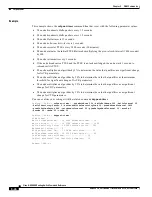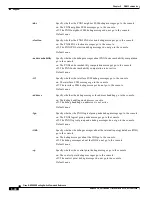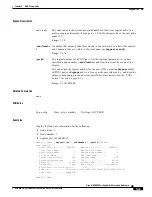
5-60
Cisco MGX 8850 Routing Switch Command Reference
Release 2.0, Part Number 78-10467-04 Rev C0, October 2001
Chapter 5
PNNI Commands
dsppnni-election
dsppnni-election
Display PNNI Election—display information for election a peer group leader.
The dsppnni-election command displays parameters and current status related to the election of a peer
group leader (PGL). This command and related information applies to multi-peer groups only. The
cnfpnni-election command lets you specify election parameters.
In a multi-peer group environment, each peer group can elect one PGL. Such an election takes place for
every level of the hierarchy. (For example, if three levels exist, three PGL elections occur.)
Cards on Which This Command Runs
PXM45
Syntax
dsppnni-election
[node-index]
Syntax Description
Objects Displayed
The following parameters are displayed for each node.
node-index
The system-generated node index indicates the relative level of the logical node
within a multi-peer group on the switch. The range is 1–10. The lowest node is 1,
and the highest is 10.
(Note that node index is inversely related to the node level, which you specify
through such commands as cnfpnni-node, for example, and has a range of 1–104.
The lowest node level is 104. When you add a logical node to the hierarchy on a
switch, the system generates the node index.)
Range: 1–10
Default: 1
Node-index
The node index has a range of 1–10.
PGL state
OperNotPGL, OprPGL, starting, and so on.??
Priority
This node’s leadership priority in a peer group.
Initialization time
The number of seconds that this node delays advertising its choice of
preferred PGL.
















































